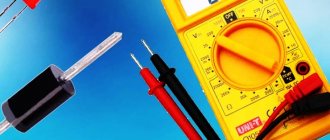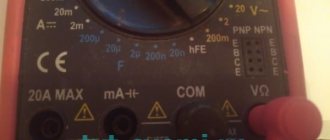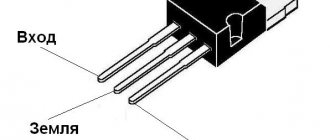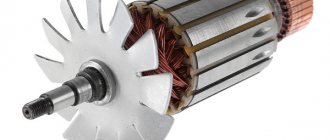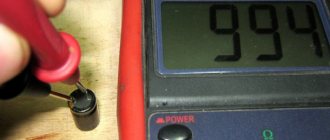Briefly about the device
Structure of a pulse power supply.
Compared to a conventional power supply, the pulse generator has a rather complex circuit design. The mains voltage passes through the filter, is rectified and smoothed. The constant voltage is supplied to the inverter, where pulses with an amplitude of about 300 volts and a frequency of several kilohertz or tens of kilohertz are “cut” from it using transistor switches. The keys are controlled by a special circuit designed as a generator.
If the source is unregulated and unstabilized, then the generator simply generates pulses of a certain frequency. If stabilization and regulation of the output voltage is needed, this is done using pulse width modulation (PWR, PWM). The pulses follow at a constant frequency, and the voltage is regulated by changing their length. In the same way, you can limit the output current, as well as protect against overload or short circuit. For this purpose, adjustment (feedback) circuits are provided - permanent or with the possibility of online adjustment.
The pulses converted to the secondary winding are rectified in the usual way, pass through a smoothing filter and are supplied to the consumer. Due to the high conversion frequency, the dimensions of the pulse transformer are small. The capacitance (and size) of the smoothing capacitors in the output filter is also small - due to this, the pulse generator gains in weight and size indicators.
More details here: Description of operation and design of a switching power supply
Converter design
Before you begin directly checking a pulse transformer (IT), it is advisable to know how it works, understand the principle of operation and distinguish between existing types. Such a pulse device is used not only as part of a power supply, it is used when constructing protection against short circuits in idle mode and as a stabilizing element.
A pulse transformer is used to convert the magnitude of current and voltage without changing their shape. That is, it can change the amplitude and polarity of various types of pulses, coordinate various electronic cascades with each other, and create reliable and stable feedback. Therefore, the main requirement for it is to preserve the shape of the pulse.
This is achieved by reducing parasitic quantities, such as interturn capacitance and inductance, by using small cores, the arrangement of turns, and reducing the number of windings. The main characteristics of the transformer are: power and operating voltage. Structurally, the device can be made in the following form:
- rod - the magnetic circuit of such a transformer is made of U-shaped plates wrapped around windings;
- armored - W-shaped plates are used, and the windings are located in coils, forming a kind of armor;
- toroidal - its appearance resembles the geometric figure of a torus, while it does not have coils, and the winding is wound on the core;
- mixed (armored rod) - assembled from four coils and a combined type magnetic circuit.
The magnetic core in the transformer is made of electrical steel plates, except for the toroidal form, in which it is made of rolled or ferromagnetic material. The coil frames are placed on insulators, and only copper wires are used. The thickness of the plates is selected depending on the frequency.
The arrangement of the windings can be made in a spiral, conical and cylindrical form. A feature of the first type is the use not of wire, but of a wide thin foil tape. Secondly, they are made with different insulation thicknesses, which affects the voltage between the primary and secondary windings. The third type is a structure with wire wound around a rod in a spiral.
Where to start, how to find the right scheme
The best repair option is if there is a circuit diagram for a specific power supply. In reality, everything is somewhat more complicated. Manufacturers do not include circuit diagrams in the documentation for power supplies. You have to look for them on the Internet. The problem is that even well-known manufacturers are not enthusiastic about showing off their developments, and small companies from Southeast Asia do not have their own websites at all. We have to collect from the entire network what enthusiasts have found and posted. And if it is relatively easy to find a circuit for computer power supplies, then for pulse generators intended, for example, to power LED strips, the situation is more complicated.
SMPS SKS-320.
Thus, for the SKS-320 power supply, when requesting a diagram, a well-known search engine produces only one adequate picture (obviously drawn by a volunteer from China). Using this device as an example, the troubleshooting algorithm will be described below.
Schematic diagram of the UPS SKS-320.
For other sources, the diagram may not be found at all. In this case, the best solution is to copy the circuit from the board yourself. This requires certain qualifications - you must, at a minimum, know what electronic components look like, and also have an approximate idea of the expected result. To do this, you need to know what circuit design the power supplies are made of. To make your work easier, you can mark the power paths on the board with a marker and number the elements (if they are not already numbered).
Another way is to find a similar circuit, which may not completely coincide with the real block, but this is better than nothing.
Functionality check
Transformers are mainly used in power supplies. Winding and manufacturing the transformer itself from scratch is a difficult task and not everyone can do it. Therefore, a ready-made one is taken as a basis and modernized by changing the number of turns of the secondary winding. Main transformer malfunctions:
- Breakage of conclusions.
- Damage to the magnetic circuit.
- Insulation failure.
- Combustion during short circuit.
Diagnosis begins with a visual examination. Initial diagnostics include inspection of the transformer terminals, its coils for charring, and the integrity of the magnetic circuit.
If the leads are worn out, it is necessary to clean them, and in some cases, if they are broken, to disassemble the transformer, solder them and ring them with a tester.
If the magnetic circuit is damaged, you need to replace it or find out from reference books about a similar one for a specific model, since it cannot be repaired. Individual plates can be replaced.
In the event of a short circuit, it is necessary to carry out diagnostics for operability using measuring instruments (checking the transformer with a multimeter).
When the insulation is broken, contact occurs between the turns of the windings or on the housing. It is quite difficult to determine this malfunction. To do this you need to do the following:
- Turn the device into resistance measurement mode.
- One probe should be on the housing, and the other should be connected to each terminal of the transformer in turn.
- In all cases, the device should show infinity, which indicates the absence of a short circuit on the housing.
- Regardless of the instrument readings, a breakdown in the housing exists, and it is necessary to completely disassemble the transformer and even unwind its windings to determine the cause.
To search for short-circuited turns, you need to determine where winding I (input) is and where winding II (output) is on an unknown transformer. To do this, you should use the following algorithm:
- Find out the resistance of the primary winding of a 220 volt transformer using multimeter measurements in the “resistance” mode. It is necessary to record the readings of the device. Select the winding with the highest resistance.
- Take a 50 W light bulb and connect it in series with this winding.
- Plug in for 5-7 seconds.
After this, turn off and check the windings for heating. If there is no noticeable temperature rise, then start looking for short-circuited turns. How to check a transformer for an interturn short circuit: you need to use a megohmmeter at a voltage of 1000 V. When measuring insulation breakdown, you need to ring the housing and winding terminals, as well as windings that are independent of each other, for example, terminals I and II.
It is necessary to determine the transformation coefficient and compare it with the document. If they match, the transformer is working.
There are two more verification methods:
- Direct - involves testing under load. To implement it, it is necessary to assemble the power circuit of windings I and II. By measuring the current values in the windings, and then using formulas (4), determine k and compare it with the passport data.
- Indirect methods. Includes: checking the polarity of winding terminals, determining magnetization characteristics (rarely used). The polarity is determined using a voltmeter or ammeter of magnetoelectric design with determination of the polarity at the output. When the arrow deviates to the right, the polarities coincide.
Read also: 34063 Switching circuit with a transistor
Checking a pulse transformer is quite complicated, and only an experienced radio amateur can do it. There are many ways to check the serviceability of pulse generators.
Thus, the transformer can be easily checked with a multimeter, knowing the main features and testing algorithm. To do this, you need to find out the type of transformer, find documentation on it and calculate the transformation ratio. In addition, it is necessary to carry out a visual inspection of the device.
Due to the widespread use of switching power supplies in various technologies, in the event of a breakdown, it is required to be able to independently repair them. All this, starting from low-power smartphone chargers with voltage stabilization, power supplies for digital set-top boxes, LCD and LED TVs and monitors, to the same powerful computer power supplies, ATX format, the simplest cases of repair of which, we have already considered earlier, that’s all There will be switching power supplies.
Photo – switching power supply
It was also said earlier that for us to carry out most measurements, a regular digital multimeter is sufficient. But there is one important nuance here: when checking, for example, by measuring resistance, or in audio testing mode, we can only determine a conditionally non-working part by the low resistance between its legs. Usually it is somewhere from zero to 40-50 Ohms, or a break, but then to do this you need to know what resistance there should be between the legs of the working part, which is not always possible to check. But when checking the functionality of a PWM controller, this is usually not enough. You need either an oscilloscope or a determination of its performance based on indirect evidence.
Cheap multimeter DT
The resistance between the legs may be higher than these limits, but the microcircuit may in fact not be working. But recently I came across this case: the connector of the power cable going from the power supply to the scaler had access from above for measurement only to the upper one, of the two rows of contacts on the connector, the lower one was hidden by the case, and access to it was only available from the back of the board, which makes repairs very difficult. Even a simple measurement of voltage at the connectors can be difficult in such a situation. You need a second person who agrees to hold the board, on the connector of which you will measure the voltage at the terminals on the back side of the board, and some of the parts there are under mains voltage, and the board itself is suspended. This is not always possible, often people whom you ask to hold the board are simply afraid to pick it up, especially if these are power boards. On the one hand, they do the right thing, precautions with untrained personnel should always be more strict.
PWM controller - microcircuit
So what should we do? How can you quickly and without problems conditionally check the operation of the PWM controller, and to be more precise, the power circuits, and at the same time the pulse transformer, step-up transformer that powers the backlight lamps? And it's very simple. I recently found one interesting method on YouTube, for masters, the author explained everything very clearly. I'll start from afar.
What is, simply put, a regular transformer? These are two or more windings on one core. But there is one nuance here that we will take advantage of: the core, like the windings themselves, in theory can be separate and simply be nearby, close to each other. The parameters will deteriorate greatly, but for our purposes this will be more than enough. So, around each transformer, or inductor, with a significant number of turns, after turning on the power to the circuit, there is a magnetic field, and it is greater, the more turns the winding of the transformer, or inductor, has. What will happen if we apply another inductor, for example with an inductance of 470 μH, to the winding of a transformer or inductor connected to the device’s network, and for our probe we need just such a one, loaded with an LED? For example, like the one in the photo below:
Probe for checking pulsed power supplies
In other words, the magnetic field of the inductor or transformer will penetrate the turns of our inductor, and a voltage will appear at its terminals, which can be used, in our case, to indicate the operability of the power supply circuit. Of course, you need to bring the probe as close as possible to the part being tested, and with the throttle down. What do the parts on the board that we need to touch with our probe look like?
The pulse transformer is circled in red on the board, and the backlight transformer is circled in green. If the circuit is working properly, when you bring the probe close to them, the LED should light up. This means that power is supplied to our, figuratively speaking, inductance being tested. Let's look at it in practice. If the output transistor is broken, the pulse transformer will not work.
Switching power supply circuit
In the diagram it is again highlighted in red. If the Schottky diode is broken, at the output, after the transformer, there will be no indication on the filter choke. But there is one nuance here: if the inductor on the board has a small number of turns, the glow will be either barely noticeable or absent altogether. Likewise, if, for example, transistor switches or diode assemblies are broken, through which power is supplied to the step-up transformer, for backlight lamps, LCD monitor or TV, there will be no indication when checking on this transformer.
Photo choke for probe
The cost of this choke in a radio store is only 30 rubles; they are also sometimes found in ATX power supplies, a regular LED, or 5 rubles in a glass flask. As a result, we have a simple, cheap, and very useful device for repairs, which allows us to carry out preliminary diagnostics of a switching power supply within literally one minute. Relatively speaking, with this probe you can check whether there is voltage on all the parts shown in the following photo.
Chokes and transformers
I have been using this probe for only 3-4 days so far, but I already believe that I can recommend it for use to all beginning radio amateurs - repairmen who do not yet have an oscilloscope in their home workshop. Also, this sampler may be useful to those who repair electronic equipment on the road. Happy repairs to everyone – AKV.
Methods for checking line transformers
The line transformer in kinescope televisions ( TDKS or whatever it is also designated on FBT ) is a fairly important unit: in addition to its direct role (producing high voltage for the kinescope), it very often plays the role of secondary voltage sources. It is very often used to obtain supply voltages for vertical scanning; from it the necessary voltage is obtained for heating the kinescope and video amplifiers.
Read also: How to sharpen knives correctly with a boat whetstone
In addition, a faulty TDKS can also cause the horizontal transistor to burn out. Therefore, in practice, quite often there is a need to check TDKS in order to localize the fault.
And here are a few ways to check TDKS from various sources:
Basic faults of a switching power supply
External manifestations of a malfunction may be as follows:
- extraneous noise, smell of smoke, burnt insulation when turned on (at idle or under load);
- The switching power supply does not start when turned on - there is no power-on indication, there is no output voltage (or all voltages);
- one of the output voltages is missing (if the power supply has several channels);
- unstable output voltage;
- increased or decreased output voltage.
Separately, it is necessary to highlight a malfunction when the fan of a unit with forced cooling does not turn on. The problem itself does not affect performance, but in the near future it may lead to overheating and breakdown.
If the first problem on the list is observed, the power supply must be immediately de-energized and not connected to the 220 volt network until the problem is eliminated.
Basic information about transformers
To convert alternating voltage ratings, special electrical machines—transformers—are used.
A transformer is an electromagnetic device designed to convert alternating voltage and current of one magnitude into alternating current and voltage of another magnitude.
Device and principle of operation
It is used in all consumer power supply schemes, as well as for transmitting electricity over long distances. The transformer design is quite primitive:
- The ferromagnetic core is made of a ferromagnetic material and is called a magnetic core. Ferromagnets are substances that have spontaneous magnetization; the parameters (atoms have constant spin or orbital magnetic moments) vary greatly due to the magnetic field and temperature.
- Windings: primary (mains voltage is connected) and secondary (power supply to a consumer or group of consumers). There can be more than 2 secondary windings.
- Additional components are used for power transformers: coolers, gas relays, temperature indicators, moisture absorbers, current transformers, protection systems and continuous oil regeneration.
The principle of operation is based on the conductor being in an alternating electric field. When a conductor moves, for example, a solenoid (coil with a core), a voltage can be removed at its terminals, which depends directly proportionally to the number of turns. This approach is implemented in a transformer, but it is not the conductor that moves, but the electric field formed by alternating current. It moves along a magnetic circuit made of ferromagnet. Ferromagnetic is a special alloy ideal for the manufacture of transformers. Basic materials for cores:
- Electrical steel contains a large mass fraction of silicon (Si) and is combined under high temperature with carbon, the mass fraction of which is no more than 1%. Ferromagnetic properties are not clearly expressed, and eddy current losses (Foucault currents) occur. Losses increase directly proportionally with increasing frequency. To solve this problem, Si is added to carbon steel (E42, E43, E320, E330, E340, E350, E360). The abbreviation E42 stands for: E - electrical steel containing 4% - Si with 2% magnetic losses.
- Permalloy is a type of alloy and its constituent parts are nickel and iron. This species is characterized by a high value of magnetic permeability. Used in low-power transformers.
When current flows through the primary winding (I), a magnetic flux F is formed in its turns, which propagates along the magnetic circuit to winding II, as a result of which an EMF (electromotive force) is formed in it. The device can operate in 2 modes: load and idle.
Transformation coefficient and its calculation
Transformation ratio (k) is a very important characteristic. Thanks to it, you can identify malfunctions. The transformation ratio is a value showing the ratio of the number of turns of winding I to the number of turns of winding II. According to k, transformers are:
- Decreasing (k > 1).
- Raising (k
How can I check the UPS?
If in doubt, you can check the operation of the UPS. To do this, it must be turned on under load - some sources simply do not start at idle. As an equivalent, you can use car light bulbs if the unit is designed for an output voltage of 12 volts, or other incandescent light bulbs, connecting them in series and parallel to create the required load. If there are no suitable lamps, you can make up a load of resistors of the required resistance and required power.
A light bulb as a power supply load.
For a simple check of functionality, the current through the lamps must be at least 5..10% of the UPS rating. If the source is with forced cooling, you need to load it so that the current is at least half of the maximum allowable (or better, closer to the upper limit). This is necessary to force the temperature relay to operate to check that the fan is turned on.
Power supply repair technique
Those who are involved in restoring the functionality of electronic equipment know that 90+ percent of repairs come down to troubleshooting . Replacing a found faulty element in most cases takes little time and does not require special skills.
The second point is that impulse generators of the same type have structural weaknesses that lead to characteristic problems, but in general, troubleshooting is a creative process, and it is literally impossible to give step-by-step instructions. But it is quite possible to present a general search methodology, although one must understand that it is worthless without sufficient qualifications and the availability of instruments. At a minimum, you will need a multimeter and an oscilloscope.
Visually, you can only identify swollen and leaking oxide capacitors . Even if charred elements are visible during inspection, replacing them may not yield anything - the cause of burnout may be other components.
Swollen oxide capacitors are detected by visual inspection.
Troubleshooting
Diagnosing a faulty device must begin with analysis. For first estimates, knowledge of the power supply block diagram and the external manifestation of the malfunction is sufficient.
Location of the main elements on the SKS-320 SMPS board.
If, when turned on, the UPS shows no signs of life at all (does not heat up, no voltage indication, no subtle squeak is heard, no output voltage) or its output voltage is less than the rated voltage, then the first thing to check is the serviceability of the fuse (item 1 in the figure) . If it is OK, you need to check the voltage level on capacitor C5 (item 2, point 1 in the diagram). It should be about 300 volts. If there is no voltage, a malfunction of the high-voltage rectifier can be assumed. But first you need to make sure that ~220 volts reaches it. If not, you need to look for where it disappears.
Next you need to check the operation of the PWM controller. In this case, it is implemented on the TL494 chip (item 3). The functionality and numbering of its pins are summarized in the table.
| Function | Marking | Pin numbering | Pin numbering | Marking | Function | |
| Non-inverting input of error amplifier 1 | IN1 | 1 | 16 | IN2 | Non-inverting input of error amplifier 2 | |
| Amplifier 1 inverting input | | 2 | 15 | Amplifier 2 inverting input | ||
| Feedback | FB | 3 | 14 | Vref | Stabilized voltage +5.0 volts (current up to 10 mA) | |
| Setting the pause time between pulses (Dead time) | DTC | 4 | 13 | OTS | Mode (push-pull/single-stroke) | |
| Frequency setting circuit capacity | C | 5 | 12 | VCC | Power pin | |
| Frequency setting circuit resistance | R | 6 | 11 | C2 | Collector of output transistor 2 | |
| 0 volt | GND | 7 | 10 | E1 | Output transistor emitter 1 | |
| Output transistor collector 1 | C1 | 8 | 9 | E2 | Emitter of output transistor 2 | |
You need to check with an oscilloscope that there are antiphase pulses at outputs 8 and 11 of the microcircuit. If they are not there, you need to check the presence of supply voltage at pin 12 (item 4) of the TL494.
The shape of the pulses at pins 1 and 11 of the microcircuit.
If it is absent, you need to find the reason for the loss. If there is power, but there are no pulses, you need to check the wiring of the microcircuit.
If there is generation, you need to use an oscilloscope to verify the presence of pulses on the primary winding of transformer T1 (points 3,4 in the figure). Their amplitude should be about 150 volts. If not, you need to check the serviceability of the divider capacitors C5, C6. An ESR meter is very useful for this.
Measuring capacitor parameters using an ESR meter.
If one or both capacitors have poor insulation quality, they must be replaced. If you don’t have an ESR meter, you can measure the voltage at point 2. There should be about 150 volts - half of the voltage at point 1. If it differs significantly, this also indicates a malfunction of one or two capacitors. If everything is in order there, check the serviceability of transistors Q4 , Q5 (item 5), transformer T2 (item 7), transistors Q1 , Q2 (item 6), as well as all diodes in the driver circuit and the inverter output stage.
If everything is in order, and there are pulses on the primary winding, but not on the secondary, you need to check the transformer T1 (pos. 8), checking the integrity of all windings.
If there are pulses on the secondary winding, you need to check the rectifier elements - the secondary rectifier assembly D3 (item 9). If it is completely faulty, then there will be no output voltage. If only one diode fails, the output voltage will be lower.
Also, the cause of high and low voltage may be a malfunction of the feedback circuits. In the circuit, the voltage feedback is implemented on the operational amplifier U1 . There is nothing on the board that looks like an op-amp, therefore, there is a slight discrepancy between the modification of the power supply and the found circuit. You need to be prepared for this, and you need to cope with such a situation yourself, having understood the features of the circuitry. Current feedback is organized through inductor L1 (item 10) and a 680 Ohm shunt. By measuring the temperature on this throttle, the automatic fan switching is organized; the sensor is installed in close proximity to the throttle. You can check whether the cooler turns on when there is no corresponding load by heating the sensor using, for example, a hair dryer. If the fan does not start, you need to look for a fault.
How to Test a Pulse Transformer Using an Oscilloscope
If you take a pulse power transformer, for example a horizontal scanning transformer, connect it according to Fig. 1, apply U = 5 - 10V F = 10 - 100 kHz sinusoid to winding I through C = 0.1 - 1.0 µF, then on winding II using an oscilloscope we observe the shape of the output voltage.
Rice. 1. Connection diagram for method 1
Having “run” the AF generator at frequencies from 10 kHz to 100 kHz, you need to get a pure sinusoid in some section (Fig. 2 on the left) without emissions and “humps” (Fig. 2 in the center). The presence of diagrams in the entire range (Fig. 2. on the right) indicates interturn short circuits in the windings, etc. and so on.
This technique, with a certain degree of probability, allows you to reject power transformers, various isolation transformers, and partially line transformers. It is only important to choose the frequency range.
Rice. 2. Shapes of observed signals
Method 2
Necessary equipment:
- LF generator,
- Oscilloscope
Principle of operation:
The operating principle is based on the phenomenon of resonance. An increase (2 times or more) in the amplitude of oscillations from the low-frequency generator indicates that the frequency of the external generator corresponds to the frequency of the internal oscillations of the LC circuit.
To check, short-circuit winding II of the transformer. The oscillation in the LC circuit will disappear. It follows from this that short-circuited turns disrupt resonance phenomena in the LC circuit, which is what we wanted.
The presence of short-circuited turns in the coil will also make it impossible to observe resonance phenomena in the LC circuit.
We add that to test pulse transformers of power supplies, capacitor C had a nominal value of 0.01 µF - 1 µF. The generation frequency is selected experimentally.
Method 3
Necessary equipment: Low frequency generator, Oscilloscope.
Principle of operation:
The principle of operation is the same as in the second case, only a version of a series oscillatory circuit is used.
Rice. 4. Connection diagram for method 3
The absence (disruption) of oscillations (quite sharp) when the frequency of the low-frequency generator changes indicates resonance of the LC circuit. Everything else, as in the second method, does not lead to a sharp interruption of oscillations on the monitoring device (oscilloscope, AC millivoltmeter).
To check the operation of a pulse transformer, you can use both an analog and digital multimeter. The use of the second is preferable due to its ease of use. The essence of preparing a digital tester comes down to checking the battery and test leads. At the same time, the pointer-type device is additionally adjusted to this.
The analog device is configured by switching the operating mode to the area of measuring the minimum possible resistance. Afterwards, two wires are inserted into the tester sockets and short-circuited. Using a special construction handle, the position of the arrow is set opposite zero. If the arrow cannot be set to zero, then this indicates discharged batteries that will need to be replaced
When is the best time to contact the service?
If you do not have the minimum required equipment, it is better to contact a specialized organization that repairs switching power supplies. Without a minimum of equipment, an undertaking is doomed to failure in 99% of cases. Also, you should not hope to repair the device if there is no circuit diagram (at least in any form) and with insufficient qualifications. There is little point in undertaking repairs (and even taking them to service) in a situation where some of the elements have burned out. They can be replaced, but the insulating properties of the section of the board covered with soot will be far from those declared by the manufacturer, and you won’t have to wait long for a new malfunction.
For clarity, we recommend a series of thematic videos.
But in general, repairing impulse generators is a thankless task and not very profitable. They are not so expensive that you need to start a painstaking troubleshooting. But if there is no other choice or the process itself is enjoyable, then the review materials will be useful.
How to check a pulse transformer for interturn short circuit and open circuit
To check the integrity of the windings, it is best to use a digital tester, but you can also examine them using a pointer tester.
In the first case, the diode testing mode is used, indicated on the multimeter by the diode designation symbol in the diagram.
diode on the diagram
- To determine a break, test leads are connected to the digital device.
- One is inserted into the connectors marked V/Ω, and the second is inserted into COM.
- The roller switch is moved to the dialing area.
- The measuring probes are sequentially touched to each winding, red to one of its terminals, and black to the other. If it is intact, the multimeter will beep.
An analog tester performs the test in resistance measurement mode. To do this, the tester selects the smallest resistance measurement range. This can be implemented through buttons or a switch. The probes of the device, as in the case of a digital multimeter, touch the beginning and end of the winding. If it is damaged, the arrow will remain in place and will not deviate.
In the same way, interturn and short circuits are checked.
A short circuit may occur due to an insulation breakdown. As a result, the winding resistance will decrease, which will lead to redistribution of the magnetic flux in the device.
To carry out testing, the multimeter switches to resistance testing mode.
By touching the windings with probes, they look at the result on a digital display or on a scale (arrow deflection).
This result should not be less than 10 ohms.
To make sure that there is no short circuit on the magnetic circuit, touch the “hardware” of the transformer with one probe, and touch the second one sequentially to each winding. There should be no deviation of the arrow or appearance of a sound signal. It is worth noting that the interturn short circuit can only be measured with a tester in an approximate form, since the error of the device is quite high.
How to test a pulse transformer



